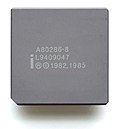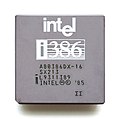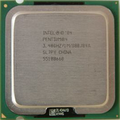CPU/Entwicklung: Unterschied zwischen den Versionen
Erscheinungsbild
Keine Bearbeitungszusammenfassung |
Intel core i7 940 top R7309478 wp.jpg |
||
| Zeile 17: | Zeile 17: | ||
{|class="wikitable" | {|class="wikitable" | ||
|+Tabelle über das Wachstum | |+Tabelle über das Wachstum | ||
|Einführungsjahr||Hersteller||Model / Codename||Anzahl Transistoren (ca.)||Verarbeitungsbreite||Kerne||Threads||Taktfrequenz||Strukturgröße | |Datei||Einführungsjahr||Hersteller||Model / Codename||Anzahl Transistoren (ca.)||Verarbeitungsbreite||Kerne||Threads||Taktfrequenz||Strukturgröße | ||
|- | |- | ||
|1975||Intel||8080||6.000||8-Bit||1||1||1-2MHz||6 μm | |[[Datei:KL Intel i8080 Black.jpeg|100px|rahmenlos|Intel 8080A Prozessor]]||1975||Intel||8080||6.000||8-Bit||1||1||1-2MHz||6 μm | ||
|- | |- | ||
|1978||Intel||8086||29.000||16-Bit||1||1||4,77-10MHz||3 μm this + Blockschaltbild | |[[Datei:KL Intel D8086.jpg|100px|rahmenlos|Intel D8086]]||1978||Intel||8086||29.000||16-Bit||1||1||4,77-10MHz||3 μm this + Blockschaltbild | ||
|- | |- | ||
|1980||Intel||8088||29.000||16-Bit||1||1||5-10MHz||3 μm | |[[Datei:KL Intel TD8088.jpg|100px|rahmenlos|Intel 8088]]||1980||Intel||8088||29.000||16-Bit||1||1||5-10MHz||3 μm | ||
|- | |- | ||
|1982||Intel||80286||134.000||16-Bit||1||1||4-26MHz||1,5 μm | |[[Datei:KL Intel i286.jpg|100px|rahmenlos|Intel CPU 80286 im PGA-Gehäuse für 8 MHz.]]||1982||Intel||80286||134.000||16-Bit||1||1||4-26MHz||1,5 μm | ||
|- | |- | ||
|1985||Intel||80386||275.000||32-Bit||1||1||12-40MHz||1,5 μm bis 1,0 μm this | |[[Datei:KL Intel i386DX.jpg|100px|rahmenlos|Intel i386DX, 16 MHz]]||1985||Intel||80386||275.000||32-Bit||1||1||12-40MHz||1,5 μm bis 1,0 μm this | ||
|- | |- | ||
|1989||Intel||80486||1.180.000||32-Bit||1||1||16-100MHz||1 μm bis 0,6 μm | |[[Datei:80486 open.jpg|100px|rahmenlos|486DX 33 MHz von Intel (geöffnet)]]||1989||Intel||80486||1.180.000||32-Bit||1||1||16-100MHz||1 μm bis 0,6 μm | ||
|- | |- | ||
|1993||Intel||Pentium||3.100.000||32-Bit||1||1||60-66MHz||0,8 μm this | |[[Datei:KL Intel Pentium P5.jpg|100px|rahmenlos|Intel Pentium P5]]||1993||Intel||Pentium||3.100.000||32-Bit||1||1||60-66MHz||0,8 μm this | ||
|- | |- | ||
| | |[[Datei:P4LGA755.png|100px|rahmenlos|Pentium 4 Prescott 3,4 GHz mit 1 MB L2-Cache.]]||2004||Intel||Pentium 4 "Prescott"||125.000.000||64-Bit||1||1-2||1,3-3,8GHz||0,90 μm | ||
|- | |- | ||
| | |[[Datei:Core 2 Duo E7500 2.93GHz.jpg|100px|rahmenlos|Core 2 Duo E7500 "Wolfdale-3M"]]||2007||Intel||Core 2 "Wolfdale"||410.000.000||64-Bit||4||4||1,3-3,33 GHz||0,45 μm | ||
|- | |- | ||
| | |[[Datei:Intel core i7 940 top R7309478 wp.jpg|100px|rahmenlos|Bloomfieldprozessor Core i7-940, 2,93GHz]]||2008||Intel||i7 Nehalem "Bloomfield"||731.000.000||64-Bit||4||4||2,6-3,2 GHz||0,45 μm | ||
|- | |- | ||
| | |[[Datei:Bild|100px|rahmenlos|Besch]]||2009||Intel||i7 Nehalem "Lynnfield"||774.000.000||64-Bit||4||4||2,8-2,9 GHz||0,45 μm | ||
|- | |- | ||
| | |[[Datei:Bild|100px|rahmenlos|Besch]]||2010||Intel||i7 Westmere "Gulftown"||1.170.000.000||64-Bit||6||6||3,2-3,6 GHz||0,32 μm | ||
|- | |- | ||
| | |Bild||2011||Intel||i7 Sandy Bridge||1.160.000.000||64-Bit||4||4||2,8-3,5 GHz||0,32 μm | ||
|- | |- | ||
| | |Bild||2012||Intel||i7 Ivy Bridge||1.400.000.000||64-Bit||4||4||2,5-3,5 GHz||0,22 μm | ||
|- | |- | ||
| | |Bild||2013||Intel||i7 Ivy Bridge-E||1.860.000.000||64-Bit||6||6||3,4-3,7 GHz||0,22 μm | ||
|- | |- | ||
| | |Bild||2014||Intel||i7 Haswell-E||2.600.000.000||64-Bit||6||6||3,0-3,7 GHz||0,22 μm | ||
|- | |- | ||
| | |Bild||2015||Intel||i7 Broadwell||3.200.000.000||64-Bit||4||8||3,3-3,7 GHz||0,14 μm | ||
|- | |- | ||
| | |Bild||2015||Intel||i7 Skylake||1.750.000.000||64-Bit||4||8||3,8-4,0 GHz||0,14 μm | ||
|- | |- | ||
| | |Bild||2017||Intel||i7 Skylake-X||Angabe vom Hersteller verwehrt||64-Bit||8||16||3,6-4,5 GHz||0,14 μm | ||
|- | |- | ||
| | |Bild||2018||Intel||i7 Coffee Lake||Angabe vom Hersteller verwehrt||64-Bit||6||12||2,4-5,0 GHz||0,14 μm | ||
|- | |- | ||
| | |Bild||2019||Intel||i9 Cascade Lake||Angabe vom Hersteller verwehrt||64-Bit||18||36||3,0-4,6 GHz||0,14 μm | ||
|- | |- | ||
| | |Bild||2020||Intel||i7 Comet Lake||Angabe vom Hersteller verwehrt||64-Bit||8||16||2,9-4,8 GHz||0,14 μm | ||
|- | |- | ||
| | |Bild||2021||Intel||Rocket Lake||Angabe vom Hersteller verwehrt||64-Bit||?||?||?||0,14 μm | ||
|2021||Intel||Rocket Lake||Angabe vom Hersteller verwehrt||64-Bit||?||?||?||0,14 μm | |||
|- | |- | ||
|} | |} | ||
| Zeile 84: | Zeile 70: | ||
=Quellen= | =Quellen= | ||
[[Kategorie:Hardware]] | |||
Version vom 27. Januar 2021, 10:43 Uhr
Erklärung der CPU
- CPU steht für "central processing unit", also Zentrale Verarbeitungseinheit. Der Hauptprozessor.
- Der Hauptprozessor ist die Funktionseinheit in einem Computer, der die eigentliche Verarbeitungsleistung erbringt.
- Er ist für die Informationsverarbeitung und die Steuerung der Verarbeitungsabläufe zuständig.
Mooresches Gesetz
1965 formulierte Gordon Moore das Mooresches Gesetz, welches kein Naturgesetz, sondern eher eine Faustformel ist.
Nach diesem Gesetz verdoppelt sich die Anzahl von Transistoren pro Flächeneinheit ca. alle 12 - 24 Monate.
Das Wachstum der CPU
| Datei | Einführungsjahr | Hersteller | Model / Codename | Anzahl Transistoren (ca.) | Verarbeitungsbreite | Kerne | Threads | Taktfrequenz | Strukturgröße |
 |
1975 | Intel | 8080 | 6.000 | 8-Bit | 1 | 1 | 1-2MHz | 6 μm |
 |
1978 | Intel | 8086 | 29.000 | 16-Bit | 1 | 1 | 4,77-10MHz | 3 μm this + Blockschaltbild |
 |
1980 | Intel | 8088 | 29.000 | 16-Bit | 1 | 1 | 5-10MHz | 3 μm |
 |
1982 | Intel | 80286 | 134.000 | 16-Bit | 1 | 1 | 4-26MHz | 1,5 μm |
 |
1985 | Intel | 80386 | 275.000 | 32-Bit | 1 | 1 | 12-40MHz | 1,5 μm bis 1,0 μm this |
 |
1989 | Intel | 80486 | 1.180.000 | 32-Bit | 1 | 1 | 16-100MHz | 1 μm bis 0,6 μm |
 |
1993 | Intel | Pentium | 3.100.000 | 32-Bit | 1 | 1 | 60-66MHz | 0,8 μm this |
 |
2004 | Intel | Pentium 4 "Prescott" | 125.000.000 | 64-Bit | 1 | 1-2 | 1,3-3,8GHz | 0,90 μm |
 |
2007 | Intel | Core 2 "Wolfdale" | 410.000.000 | 64-Bit | 4 | 4 | 1,3-3,33 GHz | 0,45 μm |
 |
2008 | Intel | i7 Nehalem "Bloomfield" | 731.000.000 | 64-Bit | 4 | 4 | 2,6-3,2 GHz | 0,45 μm |
| Besch | 2009 | Intel | i7 Nehalem "Lynnfield" | 774.000.000 | 64-Bit | 4 | 4 | 2,8-2,9 GHz | 0,45 μm |
| Besch | 2010 | Intel | i7 Westmere "Gulftown" | 1.170.000.000 | 64-Bit | 6 | 6 | 3,2-3,6 GHz | 0,32 μm |
| Bild | 2011 | Intel | i7 Sandy Bridge | 1.160.000.000 | 64-Bit | 4 | 4 | 2,8-3,5 GHz | 0,32 μm |
| Bild | 2012 | Intel | i7 Ivy Bridge | 1.400.000.000 | 64-Bit | 4 | 4 | 2,5-3,5 GHz | 0,22 μm |
| Bild | 2013 | Intel | i7 Ivy Bridge-E | 1.860.000.000 | 64-Bit | 6 | 6 | 3,4-3,7 GHz | 0,22 μm |
| Bild | 2014 | Intel | i7 Haswell-E | 2.600.000.000 | 64-Bit | 6 | 6 | 3,0-3,7 GHz | 0,22 μm |
| Bild | 2015 | Intel | i7 Broadwell | 3.200.000.000 | 64-Bit | 4 | 8 | 3,3-3,7 GHz | 0,14 μm |
| Bild | 2015 | Intel | i7 Skylake | 1.750.000.000 | 64-Bit | 4 | 8 | 3,8-4,0 GHz | 0,14 μm |
| Bild | 2017 | Intel | i7 Skylake-X | Angabe vom Hersteller verwehrt | 64-Bit | 8 | 16 | 3,6-4,5 GHz | 0,14 μm |
| Bild | 2018 | Intel | i7 Coffee Lake | Angabe vom Hersteller verwehrt | 64-Bit | 6 | 12 | 2,4-5,0 GHz | 0,14 μm |
| Bild | 2019 | Intel | i9 Cascade Lake | Angabe vom Hersteller verwehrt | 64-Bit | 18 | 36 | 3,0-4,6 GHz | 0,14 μm |
| Bild | 2020 | Intel | i7 Comet Lake | Angabe vom Hersteller verwehrt | 64-Bit | 8 | 16 | 2,9-4,8 GHz | 0,14 μm |
| Bild | 2021 | Intel | Rocket Lake | Angabe vom Hersteller verwehrt | 64-Bit | ? | ? | ? | 0,14 μm |
Hätte nie gedacht das ich mir für Informationen mal so etwas durchlese: zb. ?MICRODESIGN RESOURCES FEBRUARY 17, 1997 MICROPROCESSOR REPORT